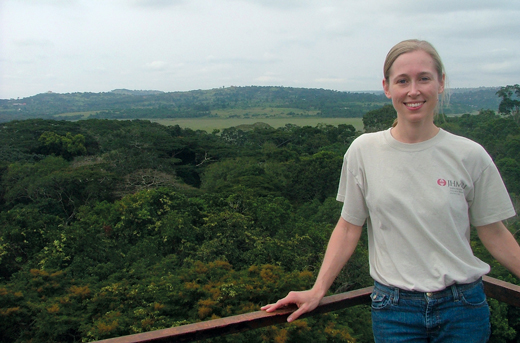
The mosquito maven
ALUMNI & FRIENDS | When the Zika virus emerged on the island of Yap in the Pacific Ocean sometime in 2007, researchers, doctors and scientists all wondered the same thing: How exactly is this happening?
Considering that the last known outbreak was 60 years prior and roughly 7,000 miles away—in 1947, in the Zika forest of Uganda, to be exact—the question was obvious, even if the answer has proven far more elusive.
For Rebekah Crockett Kading, ANR00, the mystery is part of her own fascination with one of nature’s most unpopular creatures.
“The fact that something so tiny can transmit some of the world’s most deadly diseases,” she says. “That’s what’s always interested me.”
While most of the world is now learning more about the virus—declared a public health emergency by the World Health Organization earlier this year, having already infected more than 1 million people in Brazil, with potentially devastating effects on children and those in utero—Zika is no stranger to scientists like Kading.
In fact, as a scientist with the Centers for Disease Control and Prevention, she visited the Zika forest in Uganda in 2010 to study the potential role of bats as reservoirs for mosquito-transmitted viruses. Standing on 120-foot platforms over the forest—built in the late 1940s to study the virus after its first outbreak—she made a startling observation.
Things to know about Zika:
The main culprit in spreading Zika virus—Aedes aegypti—can’t survive in more temperate areas of North America. But the Asian tiger mosquito, also capable of transmitting Zika, can. “However, because of its more opportunistic blood feeding behavior, the role the Asian tiger mosquito would play in circulation of Zika virus would be very different than that of Ae. aegypti,” says Kading. “There are a lot of unknowns as far as what North American mosquito species would play key roles in transmission of Zika virus.”
The best defense against any mosquito-borne illness is to be “vigilant, prepared and proactive,” says Kading, who keeps a can of bug spray in her son’s baseball gear. “We just make applying it part of our routine,” she adds, and recommends wearing long sleeve-shirts, pants and head nets when traveling in areas with high mosquito populations.
Towering over the trees in the canopy region, where the Aedes mosquitoes known to carry Zika virus are known to thrive, Kading could see the rich diversity of the tiny forest—and just beyond, the homes of villagers in close proximity to the vector mosquitoes.
“From that view, you could actually visualize the virus being transmitted,” she says. “It was disturbing.”
Today, Kading works as assistant professor in the Department of Microbiology, Immunology and Pathology at Colorado State University, where she is developing a research program on emerging mosquito-borne illnesses, with a focus on “one-health,” which combines disease control with ecological conservation: “the health of wildlife, of people and of the environment.”
It is a topic that originated at her alma mater.
“My story really starts at UD,” says Kading, speaking fondly of her adviser, Prof. Roland Roth, who involved her in undergraduate research on the wood thrush, and served as her academic adviser during her experiences monitoring the breeding habitats of mosquitoes on the Delaware salt marshes.
“I was initially only interested in wildlife conservation, but entomology snuck in there somehow,” she says. “In fact, the combination of both disciplines has defined my career.”



